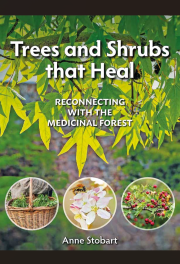Trees and Shrubs That Heal: Reconnecting with the Medicinal Forest

Anne Stobart
Permanent Publications, £25.00
It is difficult to know where this book would be placed in a library or bookshop. In the medicine section? On the gardening shelves? Possibly among the pharmaceutical or plant biochemistry texts? Under botany? It probably doesn’t matter, as it weaves all these topics together in a very clever way. The author, an academic at the University of Exeter, is a medical herbalist with a background in the history of medicine, including women healers.
Divided into two almost equal parts, the first half considers sustainable harvesting, how trees and their products can counteract infection and reduce inflammation, how bark and leaves help digestive problems, how the fruits of trees and shrubs can boost health and a final section on reconnecting with nature. In this section are also many interesting facts and figures, such as there being approximately 47 trees per person in the UK, compared with almost 422 per person in the USA. Climate change and conservation issues are addressed positively.
The second half is an alphabetical directory, using binomial names. This is perhaps the most visually appealing section as there are photographs and delightful colour illustrations. Each of the 80 species of temperate tree or shrub described has a double page spread with details about habitat, the parts used in medicine, harvest times, herbal actions, traditional and other uses, research, active constituents, sample preparation, safety notes, cultivation and a recipe. These are often for teas but there are also instructions for making poultices, air fresheners, pills, cordials, hair tonics, footbaths, vinegars, syrups, gin and more.
The phrase ‘studies show….’ is used fairly often, but not backed up by references, leaving the reader to wonder how many ‘studies don’t show….’, who carried out the study and whether it was ever repeated. However, to be fair, to include references throughout would make this a different and probably more expensive book.
Packed full of information, this book is likely to interest practising herbalists, permaculturists, anyone hoping to learn more about natural remedies, as well as gardeners wanting to know more about the trees and shrubs they grow.
Dr Sue Howarth FRSB
Author Anne Stobart has made a free downloadable PDF listing the 500 research references supporting the text available online. The supporting references are listed by plant species.


